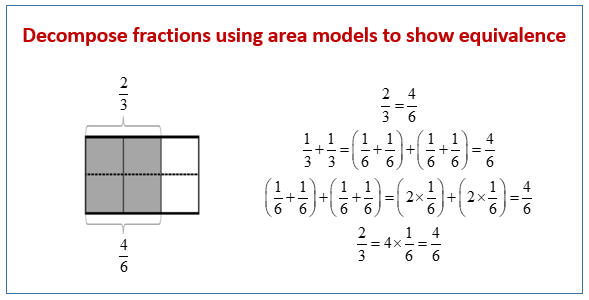Decompose Fractions using Area Models
Related Topics:
Lesson Plans and Worksheets for Grade 4
Lesson Plans and Worksheets for all Grades
More Lessons for Grade 4
Common Core For Grade 4
Free Math video lessons to help Grade 4 students learn how to decompose fractions using area models to show equivalence.
Common Core Standards: 4.NF.3b, 4.NF.4a, 4.NF.3a
New York State common Core Grade 4, Module 5, Lesson 6
Topic A: Decomposition and Fraction Equivalence
The following diagram shows how to decompose fractions using area models to show equivalence. Scroll down the page for more examples and solutions.

Grade 4 Module 5, Lesson 6
Lesson 6 Concept Development
Problem 1: Use an area model to show that 3/4 = 6/8
Problem 2: Draw an area model to represent the equivalence of two fractions and express the equivalence as the sum and product of unit fractions.
Problem 3: Decompose to create equivalent fractions by drawing an area model and then dividing the area model into smaller parts.
Lesson 6 Problem Set
- Each rectangle represents 1 whole. Draw horizontal lines to decompose each rectangle into the number of units as indicated. Use the model to give the shaded area as a sum and as a product of unit fractions. Use parentheses to show the relationship between the number sentences. The first one has been partially done for you.
a. Sixths
b. Tenths
c. Twelfths - Draw area models to show the decompositions represented by the number sentences below. Express each as a sum and product of unit fractions. Use parentheses to show the relationship between the number sentences.
a. 3/5 = 6/10
b. 3/4 = 6/8 - Step 1: Draw an area model for a fraction with the denominator of 3, 4, or 5.
Step 2: Shade in more than one fractional unit.
Step 3: Partition the area model again to find an equivalent fraction.
Step 4: Write the equivalent fractions as a number sentence. (If you’ve written a number sentence already on this Problem Set, start over.)
Lesson 6 Homework
- Each rectangle represents 1 whole. Draw horizontal lines to decompose each rectangle into the number of units as indicated. Use the model to give the shaded area as a sum and as a product of unit fractions. Use parentheses to show the relationship between the number sentences. The first one has been partially done for you.
a. Tenths
b. Eighths
c. Fifteenths - Draw area models to show the decompositions represented by the number sentences below. Express each as a sum and product of unit fractions. Use parentheses to show the relationship between the number sentences.
a. 2/3 = 4/6
b. 4/5 = 8/10 - Step 1: Draw an area model for a fraction with the denominator of 3, 4, or 5.
Step 2: Shade in more than one fractional unit.
Step 3: Partition the area model again to find an equivalent fraction.
Step 4: Write the equivalent fractions as a number sentence. (If you have written a number sentence like this one already in this homework, start over.)
Try the free Mathway calculator and
problem solver below to practice various math topics. Try the given examples, or type in your own
problem and check your answer with the step-by-step explanations.

We welcome your feedback, comments and questions about this site or page. Please submit your feedback or enquiries via our Feedback page.